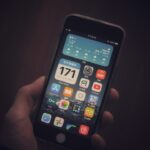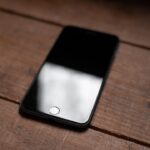The Ring/Silent switch is a small yet crucial feature located on the side of iPhones, often overlooked by users when troubleshooting sound-related issues. This physical toggle allows users to quickly switch between ringing and silent modes, providing a convenient way to manage notifications and calls. When experiencing problems with incoming calls or notifications, the first step should always be to check this switch.
If the switch is flipped towards the back of the device, it indicates that the phone is in silent mode, which would prevent any sound from alerts or ringtones. To ensure that the Ring/Silent switch is functioning correctly, users should physically inspect it for any obstructions or damage. Sometimes, dust or debris can accumulate around the switch, causing it to stick or malfunction.
If the switch appears to be stuck in one position, gently cleaning around it with a soft cloth or using compressed air can help dislodge any particles. Additionally, users should toggle the switch back and forth a few times to ensure it is operating smoothly. If the device remains unresponsive to calls or notifications after confirming that the switch is in the correct position, further troubleshooting steps will be necessary.
Key Takeaways
- Make sure the Ring/Silent switch on your iPhone is not set to silent to receive notifications and calls.
- Adjust the volume settings on your iPhone to ensure that the ringer and alerts are audible.
- Check if the Do Not Disturb mode is enabled, as it may be preventing notifications from coming through.
- Keep your iOS software up to date by regularly checking for and installing updates.
- Reset network settings if you are experiencing issues with connectivity or notifications.
- Review your list of blocked contacts to ensure that important contacts are not being blocked.
- Check for hardware issues such as a faulty speaker or microphone that may be affecting notifications.
- Contact Apple Support for further assistance if you are still experiencing issues with notifications on your iPhone.
Adjusting the volume settings
Adjusting Volume Settings
To adjust the volume settings, one can use the physical volume buttons located on the side of the device. Pressing these buttons while on the home screen will adjust the media volume, but if a call is incoming, it will adjust the ringer volume instead.
Fine-Tuning Audio Preferences
In addition to using the physical buttons, users can navigate to the Settings app to fine-tune their audio preferences further. Within Settings, selecting “Sounds & Haptics” provides access to various volume sliders for ringtones, alerts, and other notifications.
Ensuring Audible Volume and Enabled Sound Options
It’s essential to ensure that the ringer volume is set to an audible level and that any relevant sound options are enabled. For instance, if “Change with Buttons” is toggled on, users can adjust their ringer volume using the physical buttons even when they are in other apps. This feature can be particularly useful for those who frequently switch between different audio outputs and need quick access to volume adjustments.
Checking Do Not Disturb mode

Do Not Disturb (DND) mode is a feature designed to help users manage interruptions by silencing calls and notifications during specified times or under certain conditions. While this feature can be incredibly useful for maintaining focus or ensuring a peaceful night’s sleep, it can also lead to missed calls and alerts if inadvertently activated. To check if DND mode is enabled, users can swipe down from the top-right corner of their screen (on iPhone models with Face ID) or swipe up from the bottom (on models with a Home button) to access the Control Center.
The crescent moon icon indicates that DND is active. If DND mode is indeed turned on, users can tap the icon to disable it quickly. However, it’s also important to review the DND settings in the Settings app for more granular control.
Within Settings, selecting “Focus” and then “Do Not Disturb” allows users to customize their DND preferences further. For example, users can allow calls from specific contacts or enable repeated calls to come through in case of emergencies. Understanding how DND works and ensuring it is configured correctly can prevent unnecessary disruptions while also ensuring that important calls are not missed.
Updating the iOS software
| Device | iOS Version | Update Size | Update Time |
|---|---|---|---|
| iPhone 12 | 14.5 | 2.5 GB | 30 minutes |
| iPad Pro | 14.5 | 3.0 GB | 45 minutes |
| iPod Touch | 14.5 | 2.0 GB | 25 minutes |
Keeping an iPhone’s software up to date is essential for optimal performance and security. Apple regularly releases iOS updates that not only introduce new features but also fix bugs and improve overall functionality. If users are experiencing issues with sound or notifications, one of the first troubleshooting steps should be to check for any available software updates.
To do this, navigate to Settings, then select “General,” followed by “Software Update.” If an update is available, users will have the option to download and install it. Updating iOS can resolve various issues that may not be immediately apparent. For instance, a bug in a previous version of iOS might affect how notifications are delivered or how sounds are played back through the device’s speakers.
By ensuring that their device runs on the latest version of iOS, users can benefit from these fixes and enhancements. Additionally, regular updates help protect against security vulnerabilities that could compromise personal data or device functionality.
Resetting network settings
Network issues can sometimes manifest as problems with receiving calls or notifications, particularly if they rely on cellular data or Wi-Fi connectivity. Resetting network settings can be an effective way to resolve these issues without affecting other data on the device. This process restores all network-related settings to their factory defaults, which can help eliminate any misconfigurations that may be causing problems.
To reset network settings, users should go to Settings, select “General,” then scroll down to “Transfer or Reset iPhone.” From there, choosing “Reset” followed by “Reset Network Settings” will initiate the process. It’s important to note that this action will erase saved Wi-Fi passwords and VPN settings, so users should ensure they have this information readily available before proceeding. After resetting network settings, users will need to reconnect to Wi-Fi networks and re-enter passwords but may find that their ability to receive calls and notifications improves significantly.
Checking for blocked contacts

Missing Calls and Messages
Blocked contacts can lead to missed calls and messages without any notification or alert. Users may inadvertently block someone while managing their contact list or during a spam filtering process.
Checking Blocked Contacts on iPhone
To check for blocked contacts on an iPhone, navigate to Settings and select “Phone,” then scroll down to “Blocked Contacts.” This section will display a list of all numbers that have been blocked from contacting the user.
Unblocking Contacts
If a contact is found on this list that should not be blocked, users can easily remove them by tapping “Edit” in the upper right corner and then selecting the red minus sign next to the contact’s name. After unblocking a contact, it’s advisable to test whether calls and messages from that number come through as expected. This simple step can often resolve issues where important communications are missed due to accidental blocking.
Checking for hardware issues
While software settings often account for sound-related problems on an iPhone, hardware issues can also play a significant role in malfunctioning audio output. Users should conduct a thorough examination of their device for any signs of physical damage that could affect its performance. For instance, if an iPhone has been dropped or exposed to moisture, internal components such as speakers or microphones may be compromised.
To diagnose potential hardware issues, users can perform a series of tests. For example, making a call and checking if both parties can hear each other clearly can help identify microphone problems. Additionally, playing music or videos at various volumes can reveal speaker malfunctions.
If any irregularities are detected during these tests—such as distorted sound or complete silence—it may indicate a need for professional repair services. In such cases, seeking assistance from an authorized service provider or Apple Store is advisable.
Contacting Apple Support
If all troubleshooting steps have been exhausted without resolution, contacting Apple Support may be necessary for further assistance. Apple offers multiple avenues for support, including online chat, phone support, and in-person appointments at Apple Stores or authorized service providers. When reaching out for help, it’s beneficial for users to provide detailed information about their issue, including any steps already taken during troubleshooting.
Apple Support representatives are trained to assist with a wide range of issues and can guide users through advanced troubleshooting techniques or recommend repair options if needed. Additionally, they may have access to diagnostic tools that can identify underlying problems not easily detectable by users themselves. By leveraging Apple Support’s expertise, individuals can ensure they receive comprehensive assistance tailored to their specific situation, ultimately leading to a resolution of their sound-related concerns on their iPhone.
If you are experiencing issues with your iPhone not ringing for incoming calls, it could be due to a variety of reasons. One possible solution could be unlocking your iPhone 11 using a jailbreak guide, which can help troubleshoot any software issues that may be causing the problem. For more information on how to unlock your iPhone 11, check out this helpful article.










